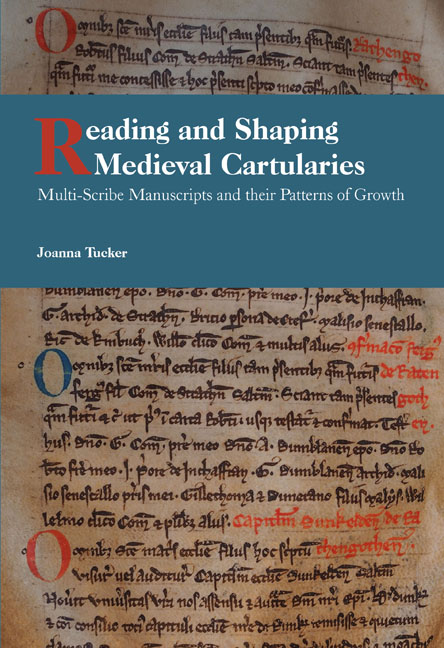Book contents
- Frontmatter
- Contents
- List of Plates
- List of Figures
- List of Tables
- Acknowledgements
- List of Abbreviations
- Conventions
- Introduction
- 1 Cartulary Studies
- 2 Analysing a Multi-Scribe Cartulary
- 3 The Creation and Growth of the Glasgow RV
- 4 The Creation and Growth of Lindores Caprington
- 5 Understanding the Patterns of Growth in Multi-Scribe Cartularies
- 6 Conclusion
- Appendix: Contents of the two Cartularies by ‘Series’
- Bibliography
- Index
- Studies in Celtic History
2 - Analysing a Multi-Scribe Cartulary
Published online by Cambridge University Press: 13 April 2021
- Frontmatter
- Contents
- List of Plates
- List of Figures
- List of Tables
- Acknowledgements
- List of Abbreviations
- Conventions
- Introduction
- 1 Cartulary Studies
- 2 Analysing a Multi-Scribe Cartulary
- 3 The Creation and Growth of the Glasgow RV
- 4 The Creation and Growth of Lindores Caprington
- 5 Understanding the Patterns of Growth in Multi-Scribe Cartularies
- 6 Conclusion
- Appendix: Contents of the two Cartularies by ‘Series’
- Bibliography
- Index
- Studies in Celtic History
Summary
In order to investigate the two cartularies in this study a new methodology will be required, one that embraces all aspects of the manuscript's current form. This methodology will be developed in this chapter through the example of the more complex of the two cartularies: Glasgow Cathedral's Registrum Vetus. Taking this manuscript as our starting point, this chapter will confront both particular and general issues that are met when working with multi-scribe medieval cartularies.
To set the cartulary in context, the chapter will begin with an overview of Glasgow Cathedral's archival history. It will then turn to the manuscript itself. Different aspects will be explored in turn: its binding, collation, scribes, and the dating of the cartulary. Most of these will need to be rethought afresh in light of the cartulary's complexities. New concepts and terminology will therefore be introduced, such as ‘relative dating’, ‘lineal sequences’, and the ‘series’. It will become apparent that, in order to fully understand the creation, and especially the ‘growth’, of this cartulary much more emphasis must be placed than is usual on the ‘physical’ evidence, in particular the binding history, the structure of the gatherings, and the spatial relationships between texts on the page. Far from being ‘auxiliary’, codicology and palaeography will be integral to the method.
Introduction to Glasgow Cathedral and its archive
While Glasgow was the site of a church built in the seventh century, it has been argued that it was only elevated to (or re-established as) an episcopal seat in the early twelfth century, under the authority of the future King David I, at that time ‘ruler’ (princeps) of the Cumbrians. The church was consecrated on 7 July 1136. Archaeological excavations have revealed that building work was happening at the cathedral in phases from the twelfth and into the thirteenth centuries. The cathedral chapter itself was a body of secular canons. Prebends were established to support the canons from the early twelfth century, beginning under Bishop John (ca 1114–1147). In 1258 the chapter adopted a version of the constitution of Salisbury Cathedral. After enjoying the status of being a ‘special daughter’ of Rome from 1175, the bishopric of Glasgow was eventually elevated to an archbishopric in 1492. At the time of the Reformation in 1560, the chapter comprised thirty-two canons.
- Type
- Chapter
- Information
- Reading and Shaping Medieval CartulariesMultiple Scribes and Patterns of Growth, pp. 34 - 90Publisher: Boydell & BrewerPrint publication year: 2021

